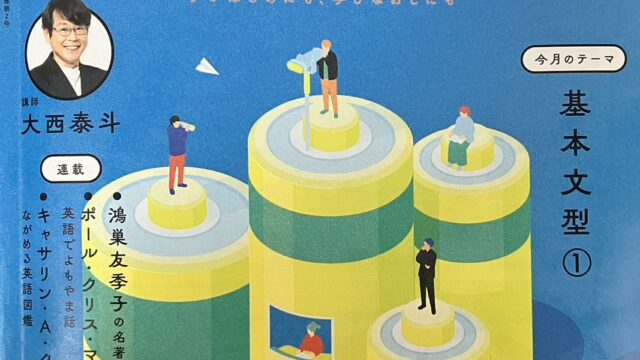May 13 Monday, 2024
Lesson 26 基本文型 他動型 – 基礎
☆Words & Phrases
Yes, some of them are from the 1950s.
**wonder:
I wonder why it is called a mouse.
**kind of ~:
**look like ~:
**tail:
It kind of looks like a mouse with a long tail, right?
**correct:
You can’t take photos here, Frankie. – Is that correct?
**regardless:
**visual sensor:
Regardless, my visual sensors can record it.
Right. You were just acting like a human. – That is so.
☆Grammar and Vocabulary
I wonder why it is called a mouse.
wh節を用いたリポート文
この文はリポート文。wonder(不思議に思う)の内容を why 以下の節が説明している
why の後ろの形は平叙文(疑問文ではない!)
「wh語 + 平叙文」の形を「wh節」として、wh疑問文(wh語を用いた疑問文)と区別すること!
wh節は疑問形を伴わない、したがって疑問の意味を持たない文の部品
why it is called a mouse =なぜそれがマウスと呼ばれている(のか)
ということ
Why is it called a mouse? =なぜそれはマウスと呼ばれているのですか?
と明確に区別する!
It kind of looks like a mouse with a long tail, right?
kind of ~「どことなく・少し・ちょっと~」
後続を和らげる表現。この例文の場合、looks like ~(~のように見える)の前に置かれ、「ちょっと〜のように見える」となっている
このフレーズは、後続の表現のレベルを「ちょっと~」と指定するため、前置きが標準。つまり「指定ルール: 指定は前に置く」に従う

☆Target Forms
You can’t take photos here.
**動詞を青字、目的語を下線で示しています
基本文型「他動型(SVO)」の基本
基本文型は動詞以降の配置パターンのこと。それぞれの文型は固有の意味を持っており、表したい状況によって使い分けられる
他動型(SVO)は「動詞+名詞(目的語)」のパターンをとる型のこと。ここでは動詞 take の後ろに名詞 photos が配置されています。この型が持つ意味は、一般に「動詞による働きかけが名詞(対象)に及ぶ」ということ
Practice
take は「(手に)取る」という動作。その対象である photos を後ろに並べます。日本語で対象物は「~を・~に」といった助詞で表されるが、英語は動詞の後ろという位置によって目的語であることが示されています。そのまま photos をポンと並べてくださいね。
take photos
↓
You can’t take photos here.
① I watch the news every morning.
→ 目的語 the news を watch の後ろに置くだけ。「~を」なんて必要なし!watch は「注視する」で、じぃーっと見る、ということ。働きかけが及んでいる
② He made a pizza for dinner.
→ make の働きかけが a pizzaに。動詞の後ろにポンと目的語を置くだけ
③ She took my seat.
→ take「取る」。この文では「奪った」になる
★Practice
R: Okay everyone. Today, let’s practice thinking about the verb and the noun as a chunk. All right?
D: That’s right folks, it’s「他動詞」time! Let’s get to it.
R: Let’s go!
– watch the news, watch the news
– I watch the news every morning.
D: Okay, let’s continue,
– made a pizza, made a pizza
– He made a pizza for dinner.
R: One more,
– took my seat, took my seat
– She took my seat.
One more time,
– She took my seat.
D: Unlock your potential.
R: Repetition is the key!
D&R: Great work.
☆Grammar in Action
①キースは彼の財布をまたなくしました。それは今月2回目です
**lose:
②あなたはネックレスをつけていますね。あなたのパートナーからの贈り物だったの?
O: By the way David, why is the past tense used here?
D: With gifts and like souvenirs「お土産」, they stop being gifts when you receive them.
③「ヒロトの日記」をダウンロードしますね。飛行機に乗っている間、見ることができますよ。
**download:
**during:
★Ending
O: Hey guys, have you ever lost your wallet or purse?
D: Ah ~, I did once a long time ago. That’s why I have all of my cards on my phone now. I went all digital.
O: Uh-huh. How about you, Roza?
R: Ah, I haven’t, but I’m always afraid of losing it. So that’s why I don’t really carry cash.
May 13 Monday, 2024
Lesson 26 基本文型 他動型 – 基礎
(日本語訳・解説付き)
☆Words & Phrases
Yes, some of them are from the 1950s.
ああ、その中のいくつかは1950年代のものだね
※ some だけで「いくつかは」という代名詞になっています!some of them は「それらのうちのいくつかは」ですね
**wonder: 不思議に思う、驚く
I wonder why it is called a mouse.
どうして、それがマウスって呼ばれるんだろう?
**kind of ~: どことなく、少し、ちょっと~
**look like ~: ~のように見える、~に似ている、~になりそうだ、~になるらしい
**tail: しっぽ
It kind of looks like a mouse with a long tail, right?
どことなく、長いしっぽを持つネズミのように見えるからじゃない?
※ a mouse with a long tail の with がポイント!with は「一緒 → 持った」の意味合いにつながっています!
**correct: 正しい、間違いのない、正確な
You can’t take photos here, Frankie. – Is that correct?
ここでは写真撮影ができないのよ、フランキー – 本当に?
**regardless: とにかく
**visual sensor: 視覚センサー
Regardless, my visual sensors can record it.
でも、僕の視覚センサーで記録できるよ
Right. You were just acting like a human. – That is so.
そうよね。あなたはただ、人間のふりをしていただけね – ソウナノダ
※ That is so. はカタい表現です。通常なら That’s right. です。フランキーは冗談で言ったのでしょう笑
☆Grammar and Vocabulary
I wonder why it is called a mouse.
なぜ、それがマウスと呼ばれるのでしょうか
wh節を用いたリポート文
この文はリポート文。wonder(不思議に思う)の内容を why 以下の節が説明している
why の後ろの形は平叙文(疑問文ではない!)
「wh語 + 平叙文」の形を「wh節」として、wh疑問文(wh語を用いた疑問文)と区別すること!
wh節は疑問形を伴わない、したがって疑問の意味を持たない文の部品
why it is called a mouse =なぜそれがマウスと呼ばれている(のか)
ということ
Why is it called a mouse? =なぜそれはマウスと呼ばれているのですか?
と明確に区別する!
It kind of looks like a mouse with a long tail, right?
それはちょっと長いしっぽを持つネズミのように見えますよね?
kind of ~「どことなく・少し・ちょっと~」
後続を和らげる表現。この例文の場合、looks like ~(~のように見える)の前に置かれ、「ちょっと〜のように見える」となっている
このフレーズは、後続の表現のレベルを「ちょっと~」と指定するため、前置きが標準。つまり「指定ルール: 指定は前に置く」に従う

☆Target Forms
You can’t take photos here.
あなたはここで写真を撮ることができません
**動詞を青字、目的語を下線で示しています
基本文型「他動型(SVO)」の基本
基本文型は動詞以降の配置パターンのこと。それぞれの文型は固有の意味を持っており、表したい状況によって使い分けられる
他動型(SVO)は「動詞+名詞(目的語)」のパターンをとる型のこと。ここでは動詞 take の後ろに名詞 photos が配置されています。この型が持つ意味は、一般に「動詞による働きかけが名詞(対象)に及ぶ」ということ
Practice
take は「(手に)取る」という動作。その対象である photos を後ろに並べます。日本語で対象物は「~を・~に」といった助詞で表されるが、英語は動詞の後ろという位置によって目的語であることが示されています。そのまま photos をポンと並べてくださいね。
take photos
↓
You can’t take photos here.
① I watch the news every morning.
私はニュースを毎朝見ます
→ 目的語 the news を watch の後ろに置くだけ。「~を」なんて必要なし!watch は「注視する」で、じぃーっと見る、ということ。働きかけが及んでいる
② He made a pizza for dinner.
彼は夕食にピザを作りました
→ make の働きかけが a pizzaに。動詞の後ろにポンと目的語を置くだけ
③ She took my seat.
彼女が私の席を取りました
→ take「取る」。この文では「奪った」になる
★Practice
R: Okay everyone. Today, let’s practice thinking about the verb and the noun as a chunk. All right?
D: That’s right folks, it’s「他動詞」time! Let’s get to it.
R: Let’s go!
– watch the news, watch the news
– I watch the news every morning.
D: Okay, let’s continue,
– made a pizza, made a pizza
– He made a pizza for dinner.
R: One more,
– took my seat, took my seat
– She took my seat.
One more time,
– She took my seat.
D: Unlock your potential.
R: Repetition is the key!
D&R: Great work.
☆Grammar in Action
①キースは彼の財布をまたなくしました。それは今月2回目です。
Keith lost his wallet again. That’s the second time this month.
**lose: 失う
②あなたはネックレスをつけていますね。あなたのパートナーからの贈り物だったの?
You’re wearing a necklace. Was it a gift from your partner?
※「着る」だけでなく、アクセサリーを「つける」も wear ですね!
O: By the way David, why is the past tense used here?
D: With gifts and like souvenirs「お土産」, they stop being gifts when you receive them.
③「ヒロトの日記」をダウンロードしますね。飛行機に乗っている間、見ることができますよ。
I’ll download Hiroto no Nikki. We can watch it during our flight.
**download: ダウンロードする
**during: ~の間
★Ending
O: Hey guys, have you ever lost your wallet or purse?
D: Ah ~, I did once a long time ago. That’s why I have all of my cards on my phone now. I went all digital.
O: Uh-huh. How about you, Roza?
R: Ah, I haven’t, but I’m always afraid of losing it. So that’s why I don’t really carry cash.
名古屋駅前にあるビジネス英語&仕事での英語雑談力をつけるための「名古屋BEGビジネス英会話ジム」
営業時間:平日 9:00~22:00 土曜日 9:00~19:00(日祝休み)
〒450-0002 愛知県名古屋市中村区名駅2丁目40-16 名駅野村ビル 5階



